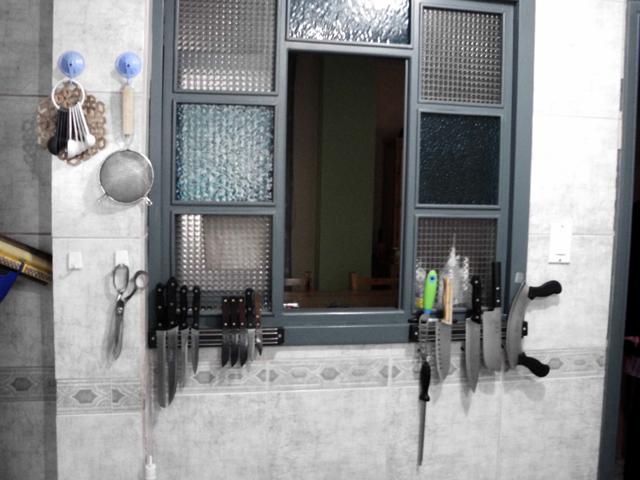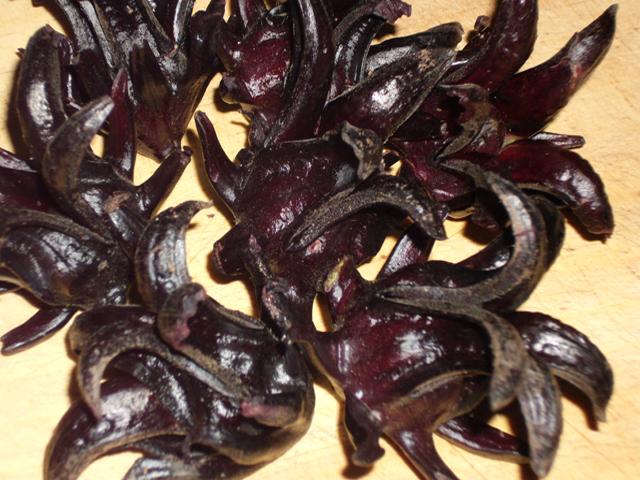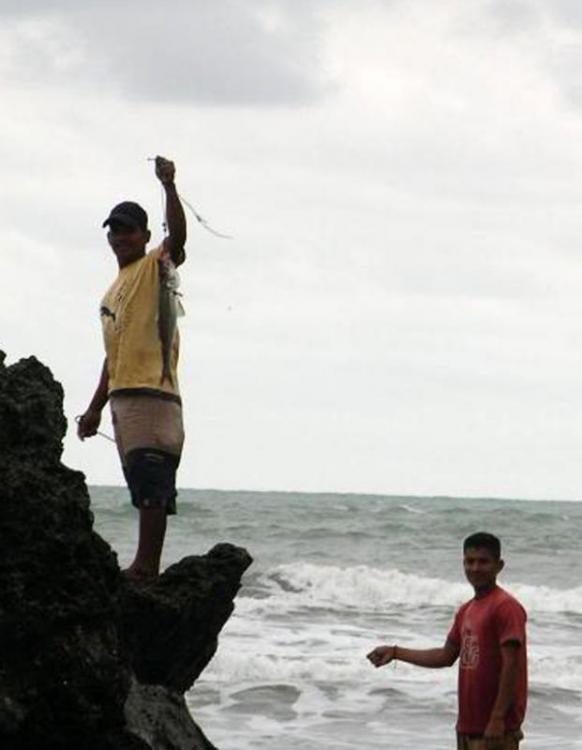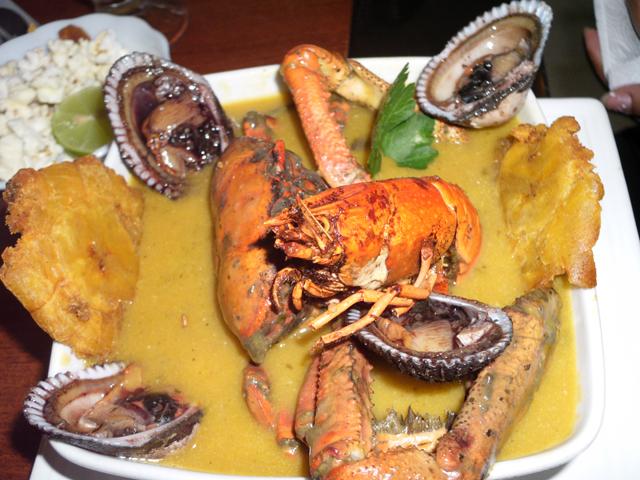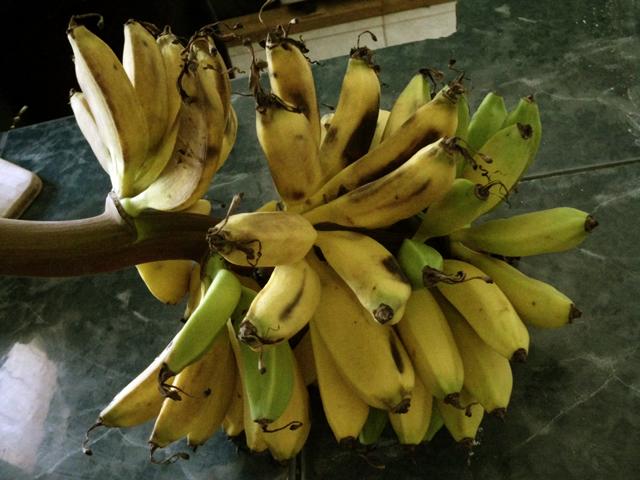-
Posts
2,383 -
Joined
-
Last visited
Content Type
Profiles
Forums
Store
Help Articles
Everything posted by Panaderia Canadiense
-
It was! Encebollado is definitely on my (long!) list of things to eat on the coast. Without further ado - c'mon in my kitchen! This house has a much smaller kitchen than the previous one did, which means that to cook in it we must be masters of efficiency. It seems cluttered, but everything is actually in its place and can be reached easily from the main worksurface. I haven't shown you my spice cabinet (it's above the coffeemaker counter) or inside my fridge (it's Sunday, so it's pathetic) - but you know what those are anyhow! Down one side of the main workspace, all of my bakery supplies are stacked in their own hermetic tubs and barrels. In the new year, I will (fingers crossed) have a dedicated kitchen and storefront for the Panaderia, and will be able to reclaim this kitchen for strictly home cookery.
-
Hi there, fellow eGulleteers, and welcome to my second foodblog! As Kerry says, we're on the road this time, which means I get to show you some of the best food Ecuador has to offer. Why, you ask? Well, because we're going on a road trip to the beaches of the coastal province of Manabí, which is recognized across the country as well as in South America for its seafood dishes. We'll be based out of the little fishing village of Puerto López, about two hours south of the province's capital, Manta. Fishing in this area is all done by men in small, oar-propelled boats with handlines and small cast nets - I'll try to get up super early one morning to find out what the catch of the day is (and possibly buy something for breakfast, if they've got Pargo Lunar in the catch....) The area is also known for its Langostinos and Langostos (giant estuarial crawdads and spiny blue lobsters, respectively) and those are often sold by their fishermen from buckets. What Heidi had to say about "buy something fresh from a guy walking down the beach with a bucket" is very true of most beaches in Manabí. At the tail end of the road trip, I'll be visiting the world's largest indigenous food and craft market and will be eating a tilapia caught from a glacially-fed crater lake - round trip in fish! I will be attempting to not eat anything twice in order to show you the immense variety available on the coast. (Meaning, if I have the encebollado you won't see me eat it again on this trip). First off, though, a bit about the teasers. The first one was indeed Roselle / Sorrel / Flor de Jamaica, the bracts of Hibiscus sabdariffia - something that I have only recently started drinking but of which I am completely enamored. A friend in the Amazon has a plantation and sends me fresh bracts (which is what's shown). I base most of my summertime iced teas and whatnot on Jamaica. Peter the Eater was quite right - it's two happy guys and a perciform fish, with a large body of water and some volcanic rocks. This photo was taken on the beach at Canoa in Manabí, and was a location teaser. Those two happy guys? They're casting simple baited handlines into the Pacific off the rocks, looking for their lunch. They called the fish they caught a "bonito" but I'm pretty sure they weren't referring to the type, but merely that it's big and beautiful (a Bonito down here is a type of mackerel and resembles a small tuna). The waters down here have an amazing variety of fish, and I'm willing to bet that what's on the line is actually a Bocachico (smallmouth striper). They were holding out for another, and didn't share, so I can't confirm that. For the curious, the volcanic rocks are a 500+ year old remnant of the last eruption of Volcan Cotopaxi, which is more than 250 km away in the Sierra - the lava hit the ocean here and gave Canoa its signature black sand beach. This is Encebollado de Mariscos (mixed seafood and onion soup) - and although it's a staple of Manabita cuisine, I ate this one in a restaurant in Ambato! Shown in the bowl are a small Langosto, a larger Cangrejo (crab), and some Concha (inky mangrove clams, something I have only eaten in Ecuador); for the curious, it's popcorn and lime in the background, and those are patacones floating in the bowl with the seafood. Encebollado de Mariscos has a strongly red-onion flavoured broth with hints of red curry and peanut; done well, it's spectacular. These are Limeño bananas that I grew myself, something that was thought to be impossible at my 3,000 meter altitude in the Sierra. And this is the starting veg for any respectable Lazy Bastard Beef Stroganstuff or similar stovetop casserole. I thought it would give me away, since nobody else here has cobalt blue tile countertops! I'll be back in a moment with photos of my current kitchen - I've moved since I last blogged, and I'm making quinua-herb and cheese minibagels in there today.
-

eG Foodblogs: Coming Attractions 2012 & 2013
Panaderia Canadiense replied to a topic in Food Traditions & Culture
Yes, road tripping to the coast. I can't tell you exactly where, because we're not sure yet! Sunday will be in Ambato, and then Monday we're on the road to goodness knows where. -
I have a recipe somewhere that uses potato starch, water, and sugar (I'll have to look for the proportions) that just tastes sort of sweet.....
- 4 replies
-
- Confections
- Dessert
-
(and 1 more)
Tagged with:
-
Elizabeth, that's a lovely crust on your fish. What did you season it with? It's a mixture of whole-wheat soda cracker crumb and faux-Ritz cracker crumb, with quinua flour and a bit of parmesan cheese; the seasoning is parsely, basil, pimentón, and a touch of "yellow seasoning" which is a blend of turmeric, mustard, nutmeg, fenugreek, cumin, oregano, and garlic powders. I actually normally use it as a gratin on things like mac n cheese, but when I'm feeling too lazy to prepare a breadcrumb coating I'll also cover fish in it.
-
Linda, you really have to butter both your silpat and your rolling pin, and work with cool to cold dough, but it can be done (with patience!) The ganache was less inspired, though, as it was "oh crud, if I use tempered cooled chocolate in this, it's going to harden and crack and be horrible when I take the dough out of its first chill-down. What do I have that's still supple at cool temps? Oh, hey, look! There's a tub of ganache at the back of the baking fridge!"
-
I've posted more details in the Adventures in Brioche thread; basically the bread was laminated with the ganache; I don't recall exactly how many turns I did; looks like 6-8 though. I just kept going until the dough was so thin that the ganache was starting to break through in spots. I've got process photos if you'd like. I'm doing something different on the same theme today; photos when it's out of the oven (it's in final proof at the moment.)
-
Simple, downhome cookin' here. Panfried tilapia with llapingachos and steamed veggies.
-
Under the heading "adventures in laminated brioche" - here's a different take on Pain au Chocolate. Instead of using butter to create poofy croissant type creatures, I used whiskey creme ganache and kept folding until it threatened to break through the layers of dough. For the curious, I'm using a 1-egg, 1/4 lb of butter, 25% quinua brioche dough, which is my go-to brioche these days (I have difficulty eating the higher-egg versions, so basically I'm a purveyor of Brioche de Povre). They were flatter than I'd have hoped, but the flavour and texture are fabulous.
-
Pain au Chocolat, made with whiskey creme ganache.
-
I'd be rolling them into small, laminated brioches.... Ooh, and now that I think of it, what I'd actually do is extract about 1/4 of them into butter, allow that to solidify, and then use the fennel butter as the laminating fat.
-
Yes, to the Whiskey Cream. Thanks PanaCan. I still have the boozy fruit from three years ago when I was going to make Black Fruitcakes...well, a lot less of it. I have been using it up in a lot of other desserts. Our daughter's BF is from Grenada and I was going to make it for him. Never quite got there. I would love your recipe although it's too late for this year I guess. I still have an unopened bottle of Mixed Essence and one of Caramel Burnt Sugar. Maybe I could make him a cupcake. It's not too late for black fruitcakes - I started about a week ago with mine. If you let them go too long, they're far too flammable..... I'll look for that whiskey creme recipe and PM you when I find it. EDIT - And yes, fruitcake jokers suck. More power to the FLF (Fruitcake Liberation Front) and our candied fruity goodness this holiday season!
-
While it's still liquid enough to pour and remain smooth in the brie-hole. It partially melts the cheese it comes into contact with, and then as the whole schmoo cools it ends up like a lime-y yummy "baked" brie. I have tried it with cold curd, and it hasn't been satisfactory. I sometimes go the extra step of actually baking it for 15 minutes or so at 350F, simply because when I make high-yolk curds I can have problems with setting without the extra baking step.
-
Ooh, ooh, on cheese! I've always preferred either mild cheeses or extremely stinky ones with curd - I thought I was the only one! Shel - for me, the ideal is either Fontina or a similar subacid semimature cheese, or a really gone old Amalattea Forte or Bleu. Although I'll also admit to hollowing out a hole in a good Brie and pouring in the curd, then allowing that to set. Mmmmm.
-
2) At least partly what you're seeing is caramelization of butter solids. I was taught that a blonde roux is made starting with a pale beurre noisette, and that the more one allowed the butter to caramelize, the darker the roux became. 3) Since I have only ever made darker roux based on browned / caramelized butter, and never by browning it after the flour is added, I'd hesitate to implicate the Maillard reaction.... However, it's worth a try! Let us know what you find out. EDIT - yeah, I should have payed better attention in chemistry. Apparently the Maillard reaction is also responsible for caramelization, so the short answer is yes. Now I'm wondering whether I learned to make a roux incorrectly, but I am very fond of the flavour of the ones made with beurre noisette..... 4) A higher proportion of fat to flour makes a looser roux and contributes to a slacker final sauce; the reverse is a tighter roux and faster and more complete thickening. 6) Not sure, but I have noticed the following: a roux made with gluten-free flour, like quinua or amaranth, will require slightly less flour to form the right consistency, and will thicken a sauce faster than a gluten-containing flour.
-
Hmm, here it's the exact reverse. White pineapples are larger, tarter, and have softer cores; golds are smaller, much sweeter (almost too sweet), and have tough cores that are only good for extractions.
-
Ooh, I love that concept! TCD, how hard is it for you to source Ecuadorian 'Arriba' cacao in the UK? If you can get your hands on a bit, I'd highly encourage you to try it in your next set of Gran Cru/ganache pairings; 'Arriba' cacao is unique to my country and has some very interesting flavours going for it.
-
Back to the original question on how to juice a pineapple (I do this almost daily, but then again I can buy extremely nice pineapples 3-4 for $1). Chop into coarse cubes and huck 'em in the blender with about 100 mL of water (or if you're going straight to booze, you can use the same volume of rum etc), pulse until smooth, then strain out the pulp using a mesh strainer and a spatula (the spatula is to press the pulp in the strainer until it's as dry as you can get it). You'll end up with a bit of foam, but that will actually settle out if left for 15-20 minutes. I've found that pineapple juiced with rum, then hit up with a bit more rum and a dash of tonic for fizz and bitter is a lovely afternoon drink, improved only if you've got nice, sweet Valencia oranges in your pantry (one orange, juiced, plus the pineapple, rum, and tonic = dee-lish.) Now here's a question for those of you who juice your own pineapples: do you consider white-fleshed fruits to be for drinks, or do you prefer gold-fleshed?
-
Couldn't tell you - whenever I've got it, it never lasts longer than 3-4 days (I use it up) - I've never done a longevity test with it. Theoretically, though, about a month if I recall correctly.
-
David, I had a thought about your foie gras/huckleberry creation - since you're seeing primarily problems with the foie gras sticking to the molds, why not give the molds a light coat of clear gelatine before beginning, sort of like you would a chocolate mould you wished to fill? That would preserve the layered look of the dessert, encapsulate the foie gras so it doesn't stick, and should make the whole thing just slide out of the moulds when it's done. EDIT - this is what I do when I'm presenting moulds of palmito mousse with tuna belly pate and mango chutney gelee, and it does work very well.
-
I wouldn't put lemon in with limes for curd - the flavour profiles are very different. I would, however, use some zest. Now a question: are you using this curd between cake, in a pie shell, or as a topping? That will help to determine the recipe; my go-to for limes is yolks-only but I prefer a much smoother softer curd than many.
-
Fresh yeast is kept in the fridge, not the freezer.
-
In my experience yolks in something like flan contribute to richness - so adding more of them (within reason) will amp up that sensation and make the whole dessert seem more filling. A 2-yolk flan made with 4 yolks, for example, will set slightly looser but taste far creamier and richer. With curds, I understand the yolk to be an optional ingredient. When I make yolkless curd it's lighter and the curd structure is a bit tighter than with the yolks, but yolked curd is again much richer and creamier in mouthfeel.





